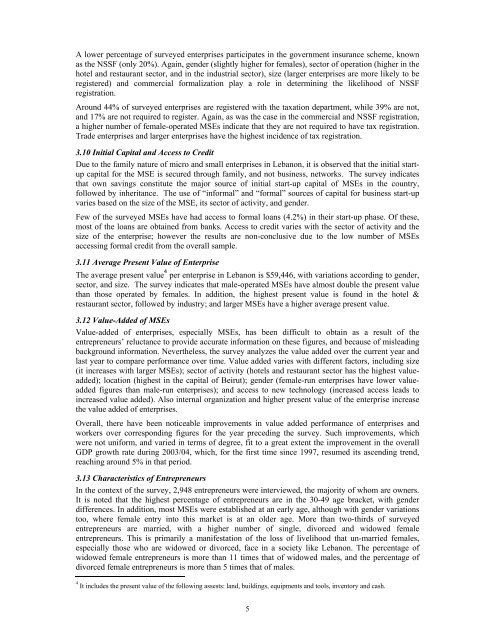MICRO AND SMALL ENTERPRISES IN LEBANON
MICRO AND SMALL ENTERPRISES IN LEBANON
MICRO AND SMALL ENTERPRISES IN LEBANON
You also want an ePaper? Increase the reach of your titles
YUMPU automatically turns print PDFs into web optimized ePapers that Google loves.
A lower percentage of surveyed enterprises participates in the government insurance scheme, knownas the NSSF (only 20%). Again, gender (slightly higher for females), sector of operation (higher in thehotel and restaurant sector, and in the industrial sector), size (larger enterprises are more likely to beregistered) and commercial formalization play a role in determining the likelihood of NSSFregistration.Around 44% of surveyed enterprises are registered with the taxation department, while 39% are not,and 17% are not required to register. Again, as was the case in the commercial and NSSF registration,a higher number of female-operated MSEs indicate that they are not required to have tax registration.Trade enterprises and larger enterprises have the highest incidence of tax registration.3.10 Initial Capital and Access to CreditDue to the family nature of micro and small enterprises in Lebanon, it is observed that the initial startupcapital for the MSE is secured through family, and not business, networks. The survey indicatesthat own savings constitute the major source of initial start-up capital of MSEs in the country,followed by inheritance. The use of “informal” and “formal” sources of capital for business start-upvaries based on the size of the MSE, its sector of activity, and gender.Few of the surveyed MSEs have had access to formal loans (4.2%) in their start-up phase. Of these,most of the loans are obtained from banks. Access to credit varies with the sector of activity and thesize of the enterprise; however the results are non-conclusive due to the low number of MSEsaccessing formal credit from the overall sample.3.11 Average Present Value of EnterpriseThe average present value 4 per enterprise in Lebanon is $59,446, with variations according to gender,sector, and size. The survey indicates that male-operated MSEs have almost double the present valuethan those operated by females. In addition, the highest present value is found in the hotel &restaurant sector, followed by industry; and larger MSEs have a higher average present value.3.12 Value-Added of MSEsValue-added of enterprises, especially MSEs, has been difficult to obtain as a result of theentrepreneurs’ reluctance to provide accurate information on these figures, and because of misleadingbackground information. Nevertheless, the survey analyzes the value added over the current year andlast year to compare performance over time. Value added varies with different factors, including size(it increases with larger MSEs); sector of activity (hotels and restaurant sector has the highest valueadded);location (highest in the capital of Beirut); gender (female-run enterprises have lower valueaddedfigures than male-run enterprises); and access to new technology (increased access leads toincreased value added). Also internal organization and higher present value of the enterprise increasethe value added of enterprises.Overall, there have been noticeable improvements in value added performance of enterprises andworkers over corresponding figures for the year preceding the survey. Such improvements, whichwere not uniform, and varied in terms of degree, fit to a great extent the improvement in the overallGDP growth rate during 2003/04, which, for the first time since 1997, resumed its ascending trend,reaching around 5% in that period.3.13 Characteristics of EntrepreneursIn the context of the survey, 2,948 entrepreneurs were interviewed, the majority of whom are owners.It is noted that the highest percentage of entrepreneurs are in the 30-49 age bracket, with genderdifferences. In addition, most MSEs were established at an early age, although with gender variationstoo, where female entry into this market is at an older age. More than two-thirds of surveyedentrepreneurs are married, with a higher number of single, divorced and widowed femaleentrepreneurs. This is primarily a manifestation of the loss of livelihood that un-married females,especially those who are widowed or divorced, face in a society like Lebanon. The percentage ofwidowed female entrepreneurs is more than 11 times that of widowed males, and the percentage ofdivorced female entrepreneurs is more than 5 times that of males.4It includes the present value of the following assests: land, buildings, equipments and tools, inventory and cash.5
















